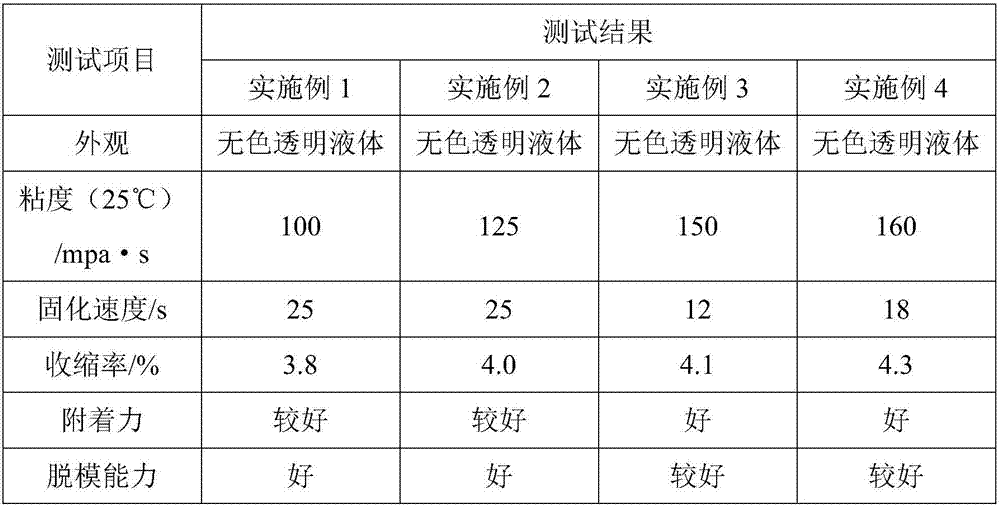Ultraviolet light polymerization hybrid system imprinting resist for large-area nanoimprint
A technology of nanoimprinting and imprinting glue, which is applied in the field of imprinting materials, can solve the problems of curing speed, mold release effect, adhesion, volume shrinkage and environmental adaptability that cannot meet the technical requirements of large-area nanoimprinting process at the same time. Solve problems such as single printing performance and poor substrate adhesion effect, to achieve the effect of increasing curing rate, simplifying equipment structure and operation, and easy demoulding
- Summary
- Abstract
- Description
- Claims
- Application Information
AI Technical Summary
Problems solved by technology
Method used
Image
Examples
Embodiment 1
[0040] An embossing glue is provided, consisting of the following components by weight:
[0041] 50 parts of 3,4-epoxycyclohexylmethyl-3,4-epoxycyclohexyl carboxylate, 10 parts of bisphenol A epoxy acrylate, 30 parts of triethylene glycol divinyl ether, triarylsulfonium salt 6 parts, 1 part of 1-hydroxycyclohexyl phenyl ketone, 1 part of silicone or silicon polyether defoamer, 2 parts of organosilane leveling agent.
[0042] First select triaryl sulfonium salt as photoinitiator, photoinitiator is 6 parts, then select 30 parts of triethylene glycol divinyl ether, place photoinitiator triarylsulfonium salt in constant pressure funnel at a certain speed Add dropwise in triethylene glycol divinyl ether, then add 1 part of 1-hydroxycyclohexyl phenyl ketone, and start the stirrer to stir at a high speed, and form a uniform solution I after 30 minutes; then choose 50 parts of 3 , 4-epoxycyclohexylmethyl-3,4-epoxycyclohexyl carboxylate and 10 parts of bisphenol A epoxy acrylate were ...
Embodiment 2
[0044] An embossing glue is provided, consisting of the following components by weight:
[0045] 40 parts of diglycidyl tetrahydrophthalate, 10 parts of bisphenol A epoxy acrylate, 40 parts of triethylene glycol divinyl ether, 6 parts of triarylsulfonium salt, 1-hydroxycyclohexylphenyl methyl 1 part of ketone, 1 part of silicone or polyether defoamer, 2 parts of organic silane leveling agent.
[0046] First choose triaryl sulfonium salt as photoinitiator, photoinitiator is 6 parts, then choose 40 parts of triethylene glycol divinyl ether, photoinitiator triaryl sulfonium salt is placed in constant pressure funnel at a certain speed Add dropwise in triethylene glycol divinyl ether, then add 1 part of 1-hydroxycyclohexyl phenyl ketone, and start the stirrer to stir at a high speed at the same time, and form a uniform solution I after 30 minutes; then select 40 parts of four Diglycidyl hydrogen phthalate and 10 parts of bisphenol A epoxy acrylate were added to solution I, and th...
Embodiment 3
[0048] An embossing glue is provided, consisting of the following components by weight:
[0049] 36 parts of 3,4-epoxycyclohexylmethyl-3,4-epoxycyclohexyl carboxylate, 12 parts of bisphenol A epoxy acrylate, 4 parts of polyurethane acrylate, 35 parts of triethylene glycol divinyl ether , 1.3 parts of 1,6-hexanediol diacrylate, 1.3 parts of trimethylolpropane triacrylate, 7 parts of triarylsulfonium salt, 2 parts of 1-hydroxycyclohexyl phenyl ketone, silicone or Silicone polyether defoamer 0.4 part, organosilane leveling agent 1 part.
[0050] First select 7 parts of triarylsulfonium salts as the photoinitiator of the cationic polymerization system, then select 35 parts of triethylene glycol divinyl ether, place the photoinitiator triarylsulfonium salts in a constant pressure funnel at a certain speed Add dropwise into triethylene glycol divinyl ether, and start the agitator to stir at high speed at the same time, and form a uniform solution I after 30 minutes; then select 36 ...
PUM
 Login to View More
Login to View More Abstract
Description
Claims
Application Information
 Login to View More
Login to View More - Generate Ideas
- Intellectual Property
- Life Sciences
- Materials
- Tech Scout
- Unparalleled Data Quality
- Higher Quality Content
- 60% Fewer Hallucinations
Browse by: Latest US Patents, China's latest patents, Technical Efficacy Thesaurus, Application Domain, Technology Topic, Popular Technical Reports.
© 2025 PatSnap. All rights reserved.Legal|Privacy policy|Modern Slavery Act Transparency Statement|Sitemap|About US| Contact US: help@patsnap.com

